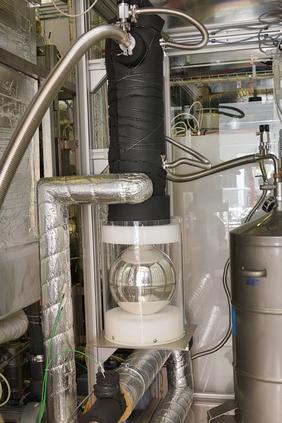ZSW succeeds in producing climate-neutral eLNG from CO2 in the air
High-tech system in line to bridge the gap to an eco-friendly future

The gleaming silver ball takes centre stage in a high-tech system consisting of a myriad of hoses, compressors, switches and buttons. It is somewhat reminiscent of the crystal ball used by a fortune-teller. And the future is also at stake here. The system was developed by the Centre for Solar Energy and Hydrogen Research Baden-Württemberg (Zentrum für Sonnenenergie- und Wasserstoff-Forschung Baden-Württemberg - ZSW) with a view to achieving climate neutrality more quickly. The demonstration system at the ZSW in Stuttgart uses electricity from renewable sources of energy to generate synthetic liquid methane from hydrogen and air, known by the name of eLNG. In contrast to LNG (liquefied natural gas), which is based on fossil gas, the energy carrier is produced in a climate-neutral manner with synthetic all-electric LNG (electrified LNG). This is because the liquid gas is obtained from green hydrogen and carbon dioxide from the ambient air.
Research on the “eLNG from Air” project funded by the Baden-Württemberg Ministry of Economic Affairs began 1.5 years ago. The project has now been successfully completed with the demonstration of the entire process chain. The technology can now be rolled out on an industrial scale.
“The production of carbon-neutral gas is an important building block on the way to a climate-neutral future. The project is our way of attempting to help our plant construction firms and component manufacturers in Baden-Württemberg to use the technology in order to tap the potential for new export operations and sales markets,” said Minister of Economic Affairs Dr. Nicole Hoffmeister-Kraut.
Existing technology modules and infrastructure systems at the ZSW were used for the project. These included a technique for extracting CO2 from the air and an electrolysis system for the production of green hydrogen. There was still a need for one innovative combined method to generate and liquefy the renewable methane in an efficient way. This procedure has now been developed at the ZSW.
Liquefied methane has an energy density 600 times higher than gaseous methane, thereby allowing intercontinental transport of large amounts of energy by ship, to name but one advantage. The existing infrastructure for LNG can therefore be repurposed in a new direction on the journey to zero. As a new climate-neutral fuel, eLNG can be used instead of diesel for shipping and haulage or as an alternative to heating oil in industry. The system for supplying CO2 from the air which was refined in the project – and the methods for scaling up the overall process – can also be transferred to other fuel synthesis processes, such as the production of synthetic kerosene.
There was great joy in the ZSW pilot plant when liquid methane flowed into the silver ball for the first time. “The amount of liquid methane was still low, but then we had the proof of concept,” said Dr. Marc-Simon Löffler, Head of Renewable Energy Sources and Processes at the ZSW. He and his colleagues are also particularly proud of the fact that all the components in the process chain – i.e. electrolysis unit, CO2 scrubber, methanation system and liquefaction unit – are in-house developments. “The system is 100 per cent made by ZSW,” added project manager Bernd Stürmer. Once the scientists had the proof that the demonstration system worked, further measures were taken to optimise the process steps. It has since been possible to increase the laboratory yield to one kilogramme per hour.
The ZSW scientists have already developed ways of scaling up the process so that it can also be used on an industrial scale. With optimum process integration, the technology will enable an efficiency level of up to 55 per cent (based on the renewable electricity used).
Having succeeded thus far, the research continues. The next step is to recruit partners from industry for the commercialisation stage with the technology modules. To this end, the System Analysis department at the ZSW is examining the potential for value added for industry in Baden-Württemberg. “The proof of concept opens a door of opportunity for companies in different industries. I would emphasise the point that the technology for extracting CO2 from air is not only an important link in the eLNG process chain but, given the great prospects for new developments, it is also very promising in terms of the global market for environmental protection initiatives,” said Maike Schmidt who heads up the System Analysis department at the ZSW. Another aim of the project is to identify potential for new export operations and sales markets for enterprises. This will set the stage for Baden-Württemberg to play a leading role as a provider of technology for the production of all-electric renewable liquid methane.
Source:
ZSW, press release, 2021-12-07.
